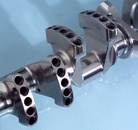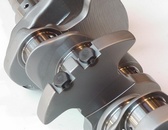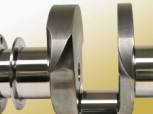Tungsten Alloy Crankshaft Facts
What is crankshaft?
The crankshaft, sometimes casually abbreviated to crank, is the part of an engine that translates reciprocating linear piston motion into rotation. To convert the reciprocating motion into rotation, the crankshaft has "crank throws" or "crankpins", additional bearing surfaces whose axis is offset from that of the crank, to which the "big ends" of the connecting rods from each cylinder attach.
Crankshaft typically connects to a flywheel, to reduce the pulsation characteristic of the four-stroke cycle, and sometimes a torsional or vibration damper at the opposite end, to reduce the torsional vibrations often caused along the length of the crankshaft by the cylinders farthest from the output end acting on the torsional elasticity of the metal.
How does crankshaft work?
The rods and bearings connects the piston to the crankshaft, when the piston moves up and down, the crankshaft is moved as describing a circle by the rods and bearings, then, the crankshaft is rotating.
What is tungsten alloy crankshaft?
The tungsten alloy crankshaft, commonly called crank, is the part of an engine which has the function of translating reciprocating linear piston motion into rotation with the component of "crank throws" or "crankpins", It typically connects to a flywheel to reduce the pulsation characteristic of the four-stroke cycle, and sometimes there is a torsional or vibration damper at the opposite end for the purpose of reducing the torsion vibrations caused along the length of the crankshaft by the cylinders farthest from the output end acting on the torsional elasticity of the metal. The tungsten alloy crankshaft is grinded to increase the mixture flow and has a special shape to reduce turbulences inside the crankcase. The tungsten alloy crankshaft is placed on the balancer and spun to determine the points where metal needs to be added or removed. The balancer indexes of the crank show the exact position and weight to be added or subtracted. The electronic brain inside the balancer head does the calculations and displays the results. The tungsten alloy crankshaft counterweight is done by two inserts which are made of tungsten alloy, to improve acceleration. Common method is adding light elements such as silicon to reduce the weight of the crankshaft.
 |
 |
 |
| Tungsten Alloy Crankshaft Facts | Tungsten Alloy Crankshaft Facts-1 | Tungsten Alloy Crankshaft Facts-2 |
Advantages for tungsten alloy crankshaft facts
Nowadays, modern engine is often made from special metal alloys, and much lighter than earlier engines. So the powder and performance of a modern engine are increased. Also, material for crankshaft has been improved, and tungsten alloy is more and more used as the material for crankshaft.
Tungsten alloy crankshaft is necessary to provide counterweights for the reciprocating mass of each piston and connecting rod to improve balance in engines, and these are typically cast as part of the crankshaft. Lead is cheap but the density is much lower than tungsten heavy alloy, and it is not environmental friendly, as for steel, tungsten heavy alloy are more than twice the density of it, so compared with other materials, tungsten heavy alloy is certainly considered t as the most appropriate crankshaft material for its properties as follows:
Tungsten Alloy Crankshaft Facts-1 Small volume but high density
Tungsten Alloy Crankshaft Facts-2 Excellent hardness
Tungsten Alloy Crankshaft Facts-3 Superior wearing resistance
Tungsten Alloy Crankshaft Facts-4 Good corrosion resistance
Tungsten Alloy Crankshaft Facts-5 Wonderful Shock resistance
Tungsten Alloy Crankshaft Facts-6 High melting point
Tungsten Alloy Crankshaft Facts-7 High temperature resistance
Tungsten Alloy Crankshaft Facts-8 Environmental friendly
If you have any interest in tungsten alloy crankshaft facts, please feel free to contact us by email: sales@chinatungsten.com, sales@xiamentungsten.com or by telephone: +86 592 5129696.






 sales@chinatungsten.com
sales@chinatungsten.com